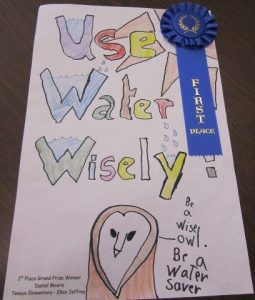An estimated 30-50% of home water use results in greywater waste. Greywater includes water from bathroom sinks, tubs, showers, and clothes washing machines. Greywater does NOT include water from toilets dishwashers, kitchen sinks or other water contaminated by bodily wastes or food pathogens.
Laundry to landscape greywater systems are cheap and relatively easy to install. The main idea is to divert water coming from a single clothes washing machine (in a 1-2 family dwelling) away from the sewer or septic line and into a landscape irrigation line. This can be done with a manually operated valve or with a second standpipe (an open pipe that the washing machine hose can manually be inserted into to divert greywater to landscaping). An optional filter may be installed prior to the perforated irrigation lines.
There are other types of systems, including ones that divert greywater from multiple sources in the house, those that store greywater and branched-drain systems, but these require construction permits and county inspections.
Since greywater can pose a potential health hazard, there are certain LGDS requirements. The washing machine must be on an exterior wall and installment of the system must not require the cutting of existing plumbing or the altering of any other mechanical, structural or electrical components. All valves and pipes must be labeled and identified as nonpotable water.
The landscape that is being irrigated must be on the same property as the source of the greywater. Greywater cannot come into contact with potable water and, except for the washing machine pump, must reach landscaping via gravity (no additional pumps involved) through pipes that are placed in disposal trenches or mulch basins throughout the landscape to be watered. Trench length is determined by the number of people occupying the home.
Greywater should not be allowed to pool on the ground, run off the property or be sprinkled into the air. Since different soils have different absorption rates (which affect pooling), it is important to assess soil type and textures prior to installation of a LGDS, and to size your mulch basins appropriately. To prevent groundwater contamination, greywater systems must not be placed within 2 feet of groundwater. This should be tested by digging a hole 3 feet deep and waiting 30 minutes to see if water pools in the bottom. If water does pool, then you cannot install a LGDS in this location.
When washing dirty diapers (or other similarly soiled, or potentially infectious clothing), and rags or clothing with grease, gasoline, paint or other chemical stains, the greywater must be diverted back to the sewer or septic system. Greywatwr must not be used indoors for flushing toilets, etc.
As yet, there is minimal research on long-term effects of greywater use on plant, human health, or on soil. Your LGDS should be designed to prevent human and pet contact and should not be used on edible root crops. Maintenance of the LGDS is also critical to keep unsanitary conditions from developing over time.
For those interested in conserving water through the installation of an LGDS, guidelines can be obtained from the Tuolumne County Community Resources Agency. Greywater standards are also posted on the California Department of Housing and Community Development website (www.hcd.ca.gov/codes/shl/Preface_ET_Emergency_Graywater.pdf).
Kathi Joye is a UCCE Master Gardener of Tuolumne County and expects that buckets in the shower and laundry greywater disposal systems will become the new norm in California.


